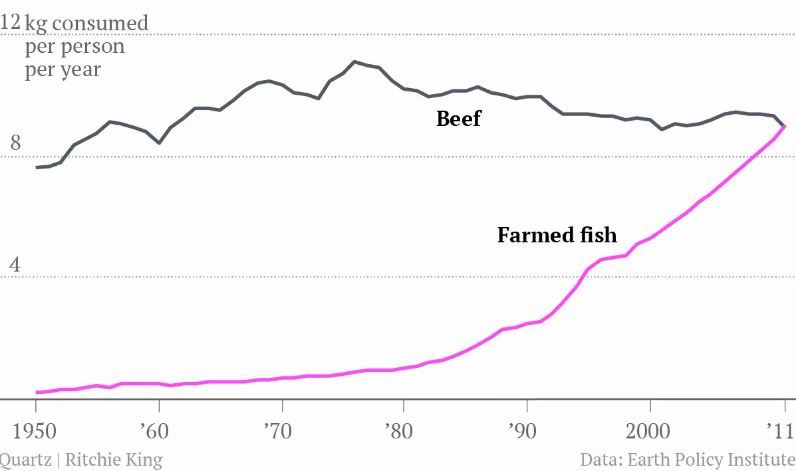Farmed fish have 2X less Omega-3, 4X less Vitamin D
The potential impact of compositional changes in farmed fish on its health-giving properties: is it time to reconsider current dietary recommendations?
Public Health Nutr. 2017 May 24:1-8. doi: 10.1017/S1368980017000696. [Epub ahead of print]
de Roos B1, Sneddon AA1, Sprague M2, Horgan GW3, Brouwer IA4.
 2014 data
2014 dataAssessment of national dietary guidelines in a number of European countries reveals that some are based on cohort studies, focusing on total seafood consumption, while others are based on the content of EPA and DHA, distinguishing between oily and other fish. The mean actual intake of fish in most countries is around or below the recommended intake, with differences in intake of fish being present between sex and age groups. Many people do not reach the national recommendation for total fish intake. Dietary recommendations for fish and EPA/DHA are based mainly on data collected more than 10 years ago. However, methods of farmed fish production have changed considerably since then.
The actual content of EPA and DHA in farmed salmon has nearly halved as the traditional finite marine ingredients fish meal and fish oil in salmon diets have been replaced with sustainable alternatives of terrestrial origin. As farmed salmon is an important source of EPA and DHA in many Western countries, our intake of these fatty acids is likely to have decreased.
In addition, levels of vitamin D and Se are also found to have declined in farmed fish in the past decade. Significant changes in the EPA and DHA, vitamin D and Se content of farmed fish means that average intakes of these nutrients in Western populations are probably lower than before. This may have consequences for the health-giving properties of fish as well as future dietary recommendations for fish intake.
📄 Download the PDF from Vitamin D Life
4X less vitamin D - from the PDF
- "One study in the USA also found that farmed salmon contained approximately 25 % of the vitamin D content of wild salmon"
- Lu Z, Chen TC, Zhang A et al. (2007) An evaluation of the vitamin D3 content in fish: is the vitamin D content adequate to satisfy the dietary requirement for vitamin D? J Steroid Biochem Mol Biol 103, 642–644
- 📄 Download the PDF from Vitamin D Life
Other references about lower Vitamin D in Farmed Fish
Farmed fish not have enough vitamin D to increase levels – RCT Feb 2014
Fatty Fish in diet increases vitamin D level a few nanograms – meta-analysis Sept 2015
Farmed salmon have 4X less vitamin D than wild salmon - Holick 2006
- Farmed salmon misses USDA vitamin D mark
- "...3.5 ounces of farm-bred salmon contains only 200 IU, while the same amount of wild salmon contains 800 to 900 IU — a significant difference from the USDA chart."
- Wild Salmon Beats Farmed for Vitamin D (Again) 2010
- Per 3.5 oz serving: Wild 500 IU, Farmed 60 IU (also had higher fat and lower Omega-3)
- That is an 8X decrease . Other references show "only" a 3X decrease in farmed salmon
More farmed fish than farmed beef? 2013

Cartoon from the web

This page was renamed on Nov 2018. There have actually been visitors to this page since it was originally made
